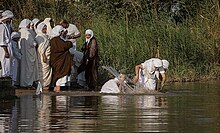

In Mandaeism, a yardna (Classical Mandaic: ࡉࡀࡓࡃࡍࡀ, romanized: iardna, lit. 'Jordan') or yardena (; Arabic: یردنا) is a body of flowing fresh water (or in Classical Mandaic: ࡌࡉࡀ ࡄࡉࡉࡀ, romanized: mia hiia, lit. 'living water'; pronounced mia h(a)yya) that is suitable for ritual use as baptismal water. The masbuta and other Mandaean rituals such as the tamasha can only be performed in a yardna. Stagnant fresh water, brackish water, and seawater are not considered to be yardnas.
Examples of yardnas
Although etymologically related to the Canaanite word yarden (Hebrew: ירדן), or the Jordan River, a yardna in Mandaeism can refer to any flowing river. Traditionally, these were typically the Euphrates (Mandaic: Praš), Tigris (Mandaic: Diglat), and Karun (Mandaic: ʿUlat) rivers. The Euphrates is called Praš Ziwa (ࡐࡓࡀࡔ ࡆࡉࡅࡀ; pronounced Fraš Ziwa) in the Ginza Rabba. In Mandaean scriptures, the Euphrates is considered to be the earthly manifestation of the heavenly yardna or flowing river (similar to the Yazidi concept of Lalish being the earthly manifestation of its heavenly counterpart).
In Worcester, Massachusetts, United States, Lake Quinsigamond (the source of the Quinsigamond River) is used as a yardna for baptism. In San Antonio and Austin, Texas, the Guadalupe River is the main yardna used.
In Australia, the Nepean River (utilized by Wallacia Mandi) and the Georges River are the yardnas that are most commonly used by Mandaeans. In Sweden, particularly during the winter, indoor pools with flowing water are used as ritual yardnas in mandis.
Heavenly counterpart
Piriawis, a river in the World of Light, is the heavenly counterpart of all yardnas on earth, which are considered by Mandaeans to be manifestations of Piriawis.
Sacramental water
There are two types of sacramental water used for Mandaean rituals, namely mambuha ("drinking water") and halalta ("rinsing water"). Both are drawn directly from a yardna.
Uthras
Mandaean texts mention various uthras watching over yardnas.
Book 14 of the Right Ginza mentions Adathan and Yadathan as the guardians of the "first yardna" (yardna qadmayya).
Shilmai and Nidbai are the two guardian uthras (celestial beings) watching over Piriawis, the heavenly yardna in the World of Light.
See also
References
- The Gnostic Bible (2003) (p. 810). New Seeds Books
- Gelbert, Carlos (2005). The Mandaeans and the Jews. Edensor Park, NSW: Living Water Books. ISBN 0-9580346-2-1. OCLC 68208613.
- ^ Buckley, Jorunn Jacobsen (2002). The Mandaeans: ancient texts and modern people. New York: Oxford University Press. ISBN 0-19-515385-5. OCLC 65198443.
- Nasoraia, Brikha (2022). The Mandaean Rivers Scroll (Diwan Nahrawatha): an analysis. London: Routledge. ISBN 978-0-367-33544-1. OCLC 1295213206.
- ^ Gelbert, Carlos (2011). Ginza Rba. Sydney: Living Water Books. ISBN 9780958034630.
- Nasoraia, Brikha H.S. (2021). The Mandaean gnostic religion: worship practice and deep thought. New Delhi: Sterling. ISBN 978-81-950824-1-4. OCLC 1272858968.
- "Worcester branch of Mandaean faith works to plant roots". 2014-12-12. Retrieved 2022-01-27.
- Busch, Matthew; Ross, Robyn (18 February 2020). "Against The Current". Texas Observer. Retrieved 8 November 2021.
- Smith, David Maurice (2015-07-30). "An Ancient Baptism in Sydney". Roads & Kingdoms. Retrieved 2021-10-30.
- Sedrati, Anass (2018). "Mandaeism - A religion between Sweden and the Middle East". Stockholm: KTH Royal Institute of Technology.

